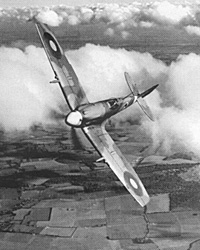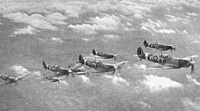 There were no really successful shooting parameters above 5 degrees deflection. Most kills were from behind, coming down on the enemy, or head-on, on in 5 degrees deflection.
There were no really successful shooting parameters above 5 degrees deflection. Most kills were from behind, coming down on the enemy, or head-on, on in 5 degrees deflection.
- --Air Commodore Alan C. Deere, 22 victories
Air combat systems matured with the coming of Craig Taylor's Air Force (Battleline, 1976; TAHGC 1980). Unlike Spitfire, Air Force features a range of aircraft, from early planes such as the Spitfire I and the Dornier DO-17 to the later ME-262 and B-17G.
Taylor's experience in miniatures systems design results in a moderately complex combat resolution system that requires a few tables but only one die roll. Basically, the total firepower of the firer is checked against the range to the target to determine the hit table to be used. Factors such as the target size, pilot experience, firing aircraft's attitude (inverted), target aspect (head-on, 6 o'clock, etc.) and other factors all increase or decrease the effectiveness of the attack. Each attack is determined on a series of hit tables ranging from 1 to 20. As the hit table number increases, the number of hits and the severity of damage increases.
The tables take into account that most hits will be of the structural, non-lethal variety, i.e., an aircraft is more likely to be hit in the wings and the fuselage than in the cockpit. In conjunction, each aircraft has six hit locations: fuselage, wing, cockpit, fuel tanks, engine, and armaments. Each hit location can sustain a number of hits before the aircraft is destroyed, the exception being that armament hits do not cause an aircraft's destruction.
For example, the mighty B-17G can take 11 wing hits, 10 fuselage hits, 4 cockpit hits, 8 engine hits, and 4 fuel tank hits before succumbing to enemy fire. In comparison, the FW-190A8 can take 5 wing hits, 7 fuselage hits, 3 cockpit hits, 3 engine hits, and 4 fuel tank hits. Additionally, depending on hit location each hit causes certain effects: an engine hit reduces power, a cockpit hit restricts maneuvering options, multiple wings hits can reduce the maximum dive speed, etc.
From the firer's perspective, the heavily armed FW-190A8, firing at one-hex range would use table 20--the most lethal in the game--inflicting from five to seven hits. With this one burst, the 190 can knock out an opposing fighter with engine or cockpits hits (1-in-6 chance each), or seriously damage a B-17.
Therefore, Air Force uses a combat resolution system that is fairly simple but which simultaneously determines hit probability, hit location, hit effects, and hit total-all
four questions elegantly answered in two tables and one die roll.
Air Force features a much more detailed and much more satisfying combat system than earlier designs. As mentioned earlier, target aspect, pilot experience, and so on, are now accorded their appropriate importance in determining hit probabilities. Because of the simultaneous movement system, deflection shooting is part of the combat system, having its own table to determine how the target aspect affects the firer's shot. For example, a head-on shot has a -4 die roll modifier (drm), while a shot from 6 o'clock gains a +2 drm.
In addition, Taylor developed a very logical system for determining each aircraft's firepower. The following table lists the weapon type and firepower assigned:
- .303 Browning, 7.92 MG-17 1 FP
.50 cal Browning 2 FP
20 mm MG-FFM, MG-151 3 FP
20 mm Hispano Suiza 4 FP
30 mm Mk-108 8 FP
Thus, Air Force attempts to differentiate between the types of armaments carried by each aircraft. Rifle caliber machine guns tend to be significantly lower in firepower while 20 mm cannon tend to have higher firepower but less ammo. Moreover, cannon and machine guns have different ranges. For example, the BF-109F3's two MGs in the wings have a range of five hexes while its one cannon in the nose has a range of six. The range of the Bf-109F's cannon is better than the wing-mounted cannon of the Spitfire Vb (five hexes), although the firepower of the latter is better.
This is an attempt to show the slightly better accuracy of a weapon mounted in the center axis of the aircraft compared with wing-mounted weapons.
 Ammunition limits play a role in shot selection as well. The Spitfire V pilot, for example, must now carefully husband his mount's paltry supply of cannon ammunition. The wealth of detail in the game allows a player to breakdown the firepower of an aircraft and thus understand which weapon configurations are particularly effective.
Ammunition limits play a role in shot selection as well. The Spitfire V pilot, for example, must now carefully husband his mount's paltry supply of cannon ammunition. The wealth of detail in the game allows a player to breakdown the firepower of an aircraft and thus understand which weapon configurations are particularly effective.
Like Richthofen's War, Air Force features a small role-playing element by allowing pilots to gain experience as they progress in their campaigns. Thus, pilots may start out green, and slowly become experienced and may eventually become aces if they score five or more aerial victories. In game terms, these pilots gain beneficial attack modifiers. The Avalon Hill version of the game adds a further human dimension to combat by providing pilot characteristics. Now, a pilot can have good reflexes (allowing in effect the pilot to fire shorter bursts), good vision (allowing better spotting modifiers), and so on. Therefore, from its initial design in 1976 to its later release in 1980 by Avalon Hill, Air Force features a stronger emphasis toward simulating the human element in aerial dogfights.
The tactics for success in Air Force replicate those used by fighter pilots in World War II. Nevertheless, Air Force is lacking certain critical aspects of air combat:
- 1. There are no rules for jammingweapons can fire without any sort of breakdown.
2. There is no functional difference between cannon and machine guns-the game suggests that four rifle caliber weapons are the equivalent of one 20mm cannon.
3. The firepower for the 30mm Mk 108 is overrated-this weapon featured relatively low muzzle velocity and tended to jam a lot.
4. Hits obtained from 12 o'clock are not concentrated in the nose section-hits are scattered throughout the target.
5. It is difficult to miss, yet nearly impossible to destroy a target with one burst-the hit tables are structured such that it is difficult to completely miss a target, i.e. to inflict no hits. And yet, the hit tables also make it impossible for most fighters in the game to destroy a target with one burst of gunfire. Very few fighters (only those with very high firepower ratings, such as the Tempest, the P-47B/D, and the FW-190A8) are capable of a one-burst kill.
6. The defensive firepower of heavy bombers is overstated-B-17 and B-24 defensive fire is too effective. The Avalon Hill version of the game neatly corrects this problem by requiring heavy bomber defensive fire to be grouped into multiples of four firepower factors.
The combat system has been designed in Air Force to encourage historical tactics. Players will attempt to maneuver into optimal positions to open fire and are more likely to break off an unfruitful attack than to risk losing an experienced pilot. Despite its few weaknesses, Air Force was probably the state of the art up to its generation of air combat designs.
Tactical Level Air Combat A Survey of Combat Resolution Systems
- Introduction
First Generation Systems
Second Generation Systems
Third Generation Systems and Conclusion
Back to Table of Contents -- Against the Odds vol. 2 no. 2
Back to Against the Odds List of Issues
Back to MagWeb Magazine List
© Copyright 2003 by LPS.
This article appears in MagWeb.com (Magazine Web) on the Internet World Wide Web.
Other articles from military history and related magazines are available at http://www.magweb.com
* Buy this back issue or subscribe to Against the Odds direct from LPS.
